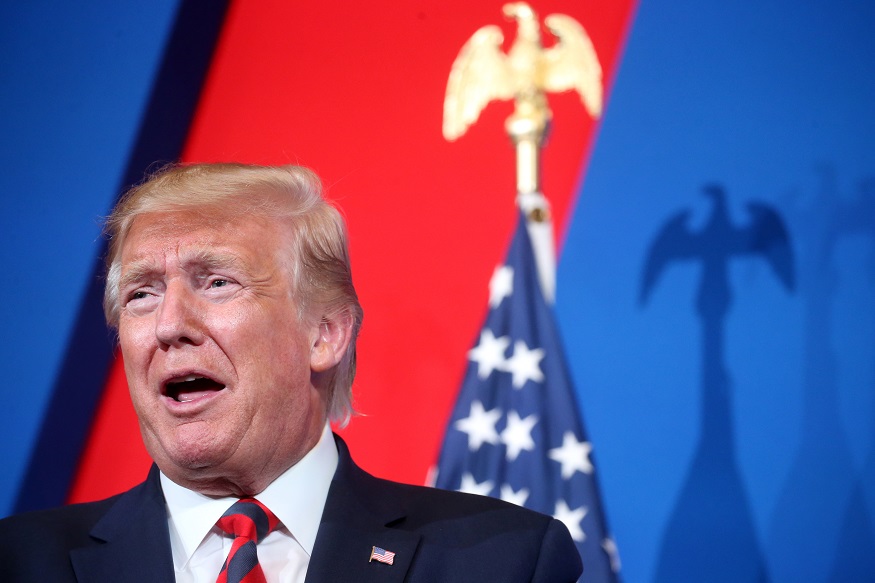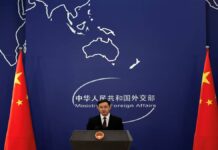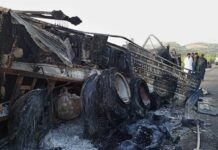WASHINGTON: The US is “locked and loaded” to respond to the unprecedented drone strikes on key Saudi oil facilities, President Donald Trump has warned, a day after his top diplomat blamed Iran for the crippling attack that has led to the biggest surge in crude oil prices since the Gulf War. The attacks on Saturday targeted Abqaiq, the site of the largest oil processing plant run by the Saudi state oil company, Aramco, and the Khurais oilfield.
Iran has denied involvement in the air attacks, which were claimed by Iran-aligned Houthi rebels in Yemen.
US Secretary of State Mike Pompeo blamed Iran for the attack, without providing any evidence, prompting Tehran to accuse Washington of deceit.
Tweeting on Sunday, President Trump stopped short of directly accusing Iran but suggested possible military action once the perpetrator was known to his administration. “Saudi Arabia oil supply was attacked. There is a reason to believe that we know the culprit, are locked and loaded depending on verification, but are waiting to hear from the Kingdom as to who they believe was the cause of this attack, and under what terms we would proceed!” Trump said.
Trump’s tweet, which appeared to raise the spectre of a US military response, served to ratchet up tensions in a region already on edge after the audacious attack on the Saudi oil field. Trump used similar language in June when he announced he had called off an attack on Iran just as the US was “cocked & loaded” to strike because he decided it would cause too many deaths for a proportionate response to Tehran’s downing of a US drone.
The coordinated strikes on key Saudi Arabian oil facilities disrupted 5 per cent of the daily global oil supply.
The attacks sent oil prices sky-rocketing on Monday, with Brent futures up USD 12 — or nearly 20 per cent — in the first few minutes of business, while West Texas Intermediate (WTI) jumped more than USD 8, or 15 per cent, AFP reported.
It was the biggest rise since the 1990-1991 Gulf War, it said. Though Trump did not name Iran in his tweet, the attack has caused another spike in tensions between the US and Tehran. Prior to Saturday, there were signs the US appeared open to new negotiations and even a potential meeting later this month between Trump and Iranian President Hassan Rouhani in New York on the sidelines of the UN General Assembly session.
A day after Secretary of State Pompeo blamed Iran for the attack on Saudi oil facilities and argued there is “no evidence the attacks came from Yemen,” a senior Trump administration official briefed CNN on information to back up Pompeo’s claims.
Pompeo did not provide evidence, but the official pointed to satellite imagery provided to CNN showing the oil facilities were struck from the northwest, suggesting an attack from Iraq or Iran, among other information.
Iran’s foreign minister Javad Zarif took to Twitter to issue a similar denial.
“Having failed at “max pressure”, @SecPompeo’s turning to “max deceit,” Zarif wrote. “The US & its clients are stuck in Yemen because of the illusion that weapon superiority will lead to military victory. Blaming Iran won’t end the disaster. Accepting our April ’15 proposal to end war & begin talks may.”
The Trump administration official pointed to the angle at which Saudi oil facilities were attacked, the numbers of points of impact and other information to argue that it is unlikely the attacks were carried out by Yemen. Instead, the official suggested the attack most likely originated in Iran or Iraq. “It is very difficult to see how these things could have come from anywhere but Iran or Iraq,” the official said.
The official said 19 Saudi targets were struck in Saturday’s attack and argued that such an attack could not be carried out with 10 drones, which the Houthis claimed to have used.
“You can’t hit 19 targets with 10 drones like that,” the official said.
The official, drawing on commercial satellite imagery shared with CNN, also noted that “all the points of impact on Saudi facilities were on the northwest side of them, which is somewhat difficult to do from Yemen.”
The official could not say whether it is possible drones from Yemen could have angled around to attack northwest facilities.
Officials quoted by the New York Times said a mix of drones and cruise missiles might have been deployed, but that not all hit their targets at Abqaiq and the Khurais oilfield.
The ABC News quoted a senior US official as saying that Trump was fully aware that Iran was responsible.
Earlier on Sunday, White House senior counsellor Kellyanne Conway said Trump has “many options on the table” when it comes to responding to the strike on Saudi Arabia’s oil production facilities.
“The President will always consider his options,” Conway said on “Fox News Sunday” when asked if Trump would still sit down with Rouhani under current circumstances.
“We’ve never committed to that meeting at the United Nations General Assembly. The President’s just said he’s looking at it,” she said. PTI







